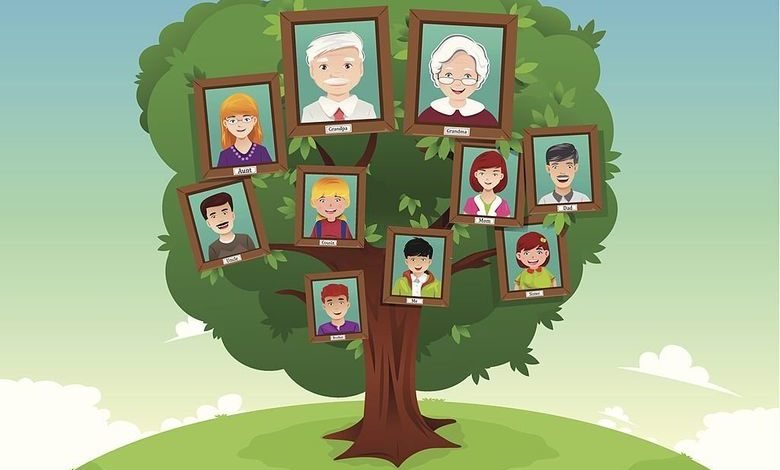In depth guide to use family trees in 2022

In a family tree, the generations of a family are depicted, along with the various ties that bind them.
Names, birth dates, marriage dates, and family photos can all be included in a family tree. Creating a family tree can be as basic as including only your immediate family members or as complex as including many generations’ worth of ancestors and showing how you are linked to each of them.
Using a family tree, you could display the following information:
- An immediate family member of a well-known historical person
- All members of the same family who share a last name
- Generations of monarchs and queens, even if they are not directly related.
As a visual representation of how closely you are related to a member of your family, family trees are a great tool for genealogy. When you look at the family tree, for example, you will discover that you are more closely linked to your sister than your cousin.
What is genealogy, and why is it important?
A genealogist is someone who studies families and their pasts. A genealogist uses a variety of approaches to compile information on ancestors and their descendents, including interviewing living relatives, poring through old documents, doing DNA tests, and more.
What exactly is a tree structure?
Hierarchical data can be represented using a tree structure or tree diagram. This refers to data that has been arranged in a specific hierarchy at several levels. As in a family tree, the individuals of one generation are arranged from oldest to youngest or present, with siblings and other members of their own generation, such as cousins, on the same level.
Using a tree structure as a visual representation, data sets can be more easily understood.
Other instances of tree architectures include:.
- Similar to a family tree, except this displays the links between animal species
- Brackets for sporting events show which teams have faced off against one another and who has advanced to the next round of play.
- A family tree of rock bands has been drawn up by English journalist Pete Frame.
Genogram explained
In addition to a family tree, a genogram depicts the medical histories of its members. Doctors and other health care providers can now see any genetic or psychological patterns in a family that may have developed throughout the course of the family’s history.
Also Read: Types of Lighted Palm Trees
What is the significance of a family tree?
An early example of a tree being used to portray a family tree is seen in a medieval painting called “The Tree of Jesse,” which represents Christ’s lineage as a tree. The Jesse Tree tells the tale of the Bible from the beginning to the end, beginning with the creation of the world.
Make a family tree because it’s a good idea!
With the help of a family tree maker online, you can find out much more about your forefathers and foremothers. Who knows? You might learn something fascinating about your forebears! You can use family trees to:
- Find out more about your background and identity.
- Find out more about your family history.
- Bring you closer to your ancestors
- Share family history with future generations through telling stories.
Other tree architectures include:
- Like a tree, however this one shows the connections between animal species instead of a family tree.
- Sports tournament brackets list the teams that have competed so far and the winners of those matches.
- British journalist Pete Frame has created a rock band family tree.
- What is a genogram, exactly?
- A genogram is similar to a family tree in that it shows the medical histories of the people that make up the family. It is now possible for doctors and other healthcare practitioners to see any genetic or psychological patterns that have emerged in a family over time.
Is there any value in having a family tree in your possession?
As seen in a medieval picture known as “The Tree of Jesse,” Christ’s ancestry is depicted as a branch on the tree. In the beginning, the world was created, and so the Jesse Tree begins the story of the Bible.
Creating a family tree is a wise decision.
Creating a family tree is a great way to discover more about your ancestors. What if? You never know what you’ll discover about your ancestors! Find out about your family’s history
- Find out more about who you are and where you’ve come from.
- Your family’s history can be found through genealogy research.
- Inspire a deeper connection with your ancestors
- Telling stories about your family’s past can help future generations learn about their roots.
Conclusion
A chart that represents family links in the form of a traditional tree structure is known as a family tree, which is sometimes referred to as genealogy or a pedigree chart. Genograms are a more thorough form of family trees that are utilized in fields such as medicine and social work.
Even though family trees look like trees, family relationships don’t usually form a tree in the strict sense used in graph theory, since distant relatives can get together and have children.
So, a person can share an ancestor with both their mother and their father. But since a parent must be born before their child, a person can’t be their own ancestor, so there aren’t any loops. In this way, family history is like a directed, non-cyclic graph.
Still, graphs showing matrilineal descent (relationships between mother and daughter) and patrilineal descent (relationships between father and son) do look like trees. If there isn’t a common ancestor, an ancestry chart is a perfect binary tree because each person has exactly one mother and one father. This gives them a regular shape.
On the other hand, a descendant chart doesn’t usually have a set layout, since a person can have any number of children or none at all.






